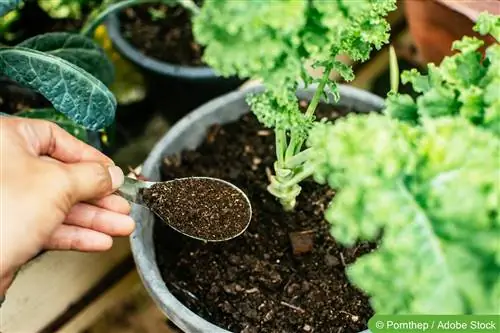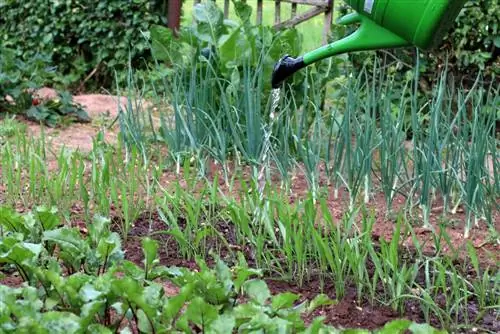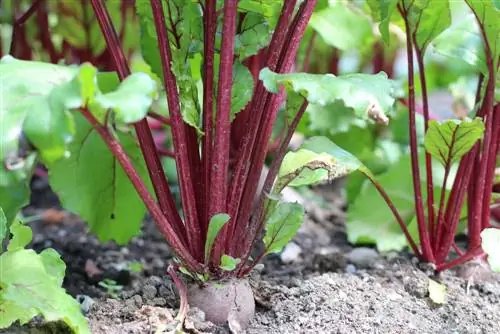- Author admin [email protected].
- Public 2023-12-17 03:39.
- Last modified 2025-06-01 06:48.
A balanced supply of nutrients creates the basis for a rich harvest in the kitchen garden. Nature-loving hobby gardeners consciously avoid using mineral-chemical fertilizers because they pollute the environment and no one wants such ingredients in their food. Fertilizing vegetables organically requires the nutrients to take a detour via breakdown by soil organisms; In return, home-grown lettuce, cauliflower, leeks and other sources of vitamins can be eaten by the whole family without any worries. You can find out how to make your own vegetable fertilizer here.
Fertilize vegetables in harmony with nature
After the knee-jerk reaction to artificial fertilizers in the 20th century, disillusionment quickly followed when the fatal side effects became known. Today, organic fertilizer reigns supreme in allotment gardens in the most diverse varieties. If vegetables are fertilized organically, the growth process proceeds exclusively according to nature's rules. In this ecological cycle, every fertilizer takes a detour prescribed by Mother Nature. While mineral s alts from the laboratory penetrate directly into the roots, organic fertilizer must first be broken down by the microorganisms. This process takes some time but ultimately provides the vegetables with all the important nutrients. The result is a rich harvest that can be consumed without worry. In addition, organic fertilization improves the soil thanks to its humus-forming properties.
Compost - the premium fertilizer for vegetables
Mature garden compost is also called the 'brown gold of Mother Nature'. The environmentally conscious hobby gardener collects suitable waste here, which is transformed into first-class vegetable fertilizer by an army of microorganisms. In a conventional compost heap, this process takes about half a year. It's quicker in the quick composter. The following materials are mainly supplied:
- organic waste, such as green waste, vegetable scraps, leaves, lawn clippings, sawdust and uncooked kitchen waste
- Manure of all kinds, such as horse manure, pig or cow manure, rabbit manure and the like
- coarse materials, such as twigs, branches, shredded wood cuttings, chopped roots
- Topsoil, used potting soil, excavation without stones
High temperatures develop within the compost heap, which initiate rotting. If the compost heap slowly collapses, it is turned over and ventilated in this way. After 4 to 6 months, well-ripened compost is dark brown and finely crumbly, like humus forest floor.
Tip:
Stone flour, baker's yeast dissolved in water and nettle manure act as compost accelerators.
Horse dung and cow dung
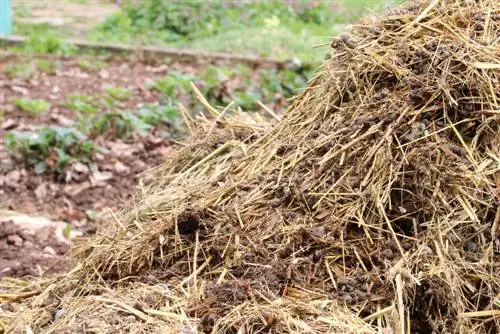
Composted over a period of 18 months, horse manure and cow manure transform into a veritable nutrient buffet for vegetable plants. To do this, 100 kilograms of fresh manure are stored in a secluded place in the garden, where they will provide around 8 to 10 kilograms of excellent vegetable fertilizer after the deadline. This is either buried 20 to 30 cm deep into the soil under the vegetable plants or raked directly into the bed soil. For hygienic reasons, fresh manure should never be used as fertilizer for vegetables without first being composted, as salmonella or coliform bacteria can hide here. Following an 18-month rot, such concerns no longer exist.
- Additives such as bentonite, a special rock powder, promote composting
- the dung heap is moved like a compost heap
Plant Jauchen - the rich liquid fertilizers for vegetables
They provide valuable nutrients in the vegetable garden, are easy to make and are easy to use. Plant manures are enjoying increasing popularity among organic vegetable fertilizers. The following recipes have proven to be excellent:
Stinging nettle manure
In a wooden vat, ferment 1 kilogram of young nettle leaves from non-flowering plants in 10 liters of water. Placed in a sunny, remote location and covered with wire mesh, the process takes about 2 weeks. The use of pond or rain water accelerates the fermentation process. Stir once a day and add a little Humofix or rock dust to combat the smell. If the foam and bubble formation decreases and the manure takes on a dark brown color, it is ready for use. Ideally, the bin is moved to a shady location to prevent unwanted secondary fermentation.
- promotes the growth of all vegetable plants
- Always administer diluted with water
Comfrey Manure
Mix one kilogram of all above-ground, crushed plant parts with 10 liters of water and allow to ferment for 14 days, similar to nettle manure. Particularly promotes tuber formation in potatoes and celery as well as root formation in tomatoes. The high potassium content strengthens the cell walls, lowers the freezing point of the cell water and prepares vegetable plants excellently for the winter.
- suitable as foliar fertilizer, diluted in a ratio of 1:50
- quickly corrects deficiency symptoms, such as chlorosis
Tip:
The stench of manure is limited if a small aquarium pump supplies the mixture with oxygen during the fermentation process.
Borage extract
Compensates for nitrogen deficiency within a short period of time. Let the leaves steep in water in a dark, cool place for over 12 hours. Fermentation must not occur. Suitable as a foliar fertilizer for vegetable plants and as a nitrogen supplier for the compost heap.
Liverwort extract
A natural strengthening agent that usefully complements any organic fertilizer. Let 50 grams of dried liverwort or leaf moss steep in 1 liter of water for one day, sieve and apply undiluted. Alternatively, fill a cylindrical pot a quarter full with fresh moss and top up with rainwater. Filter after one day and use undiluted.
- strengthens the defenses of all vegetable plants
- Spray plants weekly from spring onwards
Marigold Manure
Tomatoes, cabbage and parsley come to life when fertilized with marigold manure. At the same time, your he alth and immune system are strengthened. Simply pour any amount of the above-ground plant parts into a container, add water and let it ferment for two weeks. Before use, dilute in a ratio of 1:10 or 1:20.
- serves as a supplement to the main fertilizer for vegetables
- defends pests and diseases at the same time
Tip:
Herbs for plant manure are particularly rich in early spring before flowering.
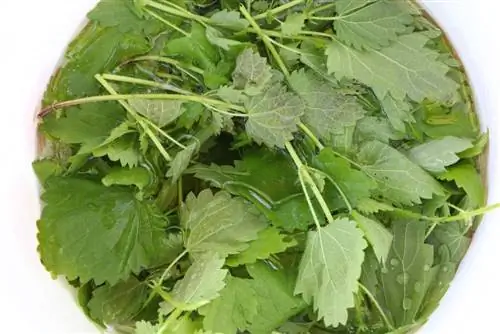
Conclusion
The mineral-chemical fertilizers have almost completely disappeared from the vegetable garden. They have made room for organic vegetable fertilizers that do not interfere artificially with the material cycle and still promote the growth and vitality of the plants. For the nature-loving hobby gardener, it is a matter of honor to make vegetable fertilizer yourself. Even in the smallest garden there is a place for a compost heap, especially since a lot of garden and kitchen waste is turned into the ultimate vegetable fertilizer. Plant manure has also established itself as an effective and environmentally friendly source of nutrients, especially nettle manure. Undoubtedly, it takes more effort to make your own vegetable fertilizer instead of taking the path of least resistance using mineral-chemical preparations. You will be rewarded for your efforts when you and your family can enjoy the carefree, he althy vegetables you grow yourself.
What you should know about fertilizing vegetables in brief
Increase crop yields
As a garden owner, you are always happy about the fresh vegetables from your own harvest. Of course, in most gardens you only have limited space, so we want to get the best possible yield from every bed. It is important to remember that the beds should be designed to be particularly versatile. A monoculture can cause excessive depletion of the soil. You should also plant the beds every year, so that carrots may be planted where the tomatoes were last year. A soil analysis at the beginning of the planting season can also be very helpful. In this way you can add exactly the vegetable fertilizer to the soil that is needed to replace the missing nutrients.
Important nutrients for vegetables
If you want good success in the vegetable garden, you should attach importance to some particularly important nutrients that are not provided in sufficient quantities by the soil. These active ingredients are nitrogen, phosphorus and potash, which are also called NPK according to their chemical symbols. That's why NPK vegetable fertilizers are usually the most effective because they provide exactly these nutrients. Fertilization is particularly effective if you do it immediately after rain. The vegetable fertilizer can spread easily in wet soil and be absorbed by the roots. Lime is also an important addition as it promotes biochemical processes. The fertilizer should also contain trace elements such as iron and copper to a lesser extent.
Mineral fertilizer or organic fertilizer
Gardening enthusiasts always ask whether they should use mineral vegetable fertilizer or whether organic fertilizer is preferable. Of course, there are many arguments in favor of organic fertilizer. There is no gradual over-fertilization, which in the long term represents an interference with the natural balance and robs plants that rely on less nutrient-poor soil of their habitat. Furthermore, the organic fertilizers have humus-forming properties that are extremely valuable for the garden.
However, it should be noted that organic fertilizers are not immediately effective. The plants can only absorb substrate dissolved in water. The organic fertilizer must first be processed and broken down by the living creatures in the soil before it can be used by the plants. The organic fertilizer therefore needs some time to become effective. This waiting period does not apply to mineral vegetable fertilizer. The s alts are immediately water soluble and ready to be absorbed by plants.
Rules you should follow when fertilizing
Of course you want to provide your vegetables with the best possible nutrients. However, over-fertilization often occurs, especially in the first year. The motto when it comes to fertilizing is: a lot is not always better. In order to add exactly the nutrients the soil needs, the hobby gardener should be informed about the condition of his soil. This can be done through a soil analysis. It makes sense to have such an analysis carried out every four to five years. The soil sample is taken after the harvest. For vegetables it should be taken from a depth of 10 to 25 cm. In addition, he should also know which nutrients the individual plants need.

